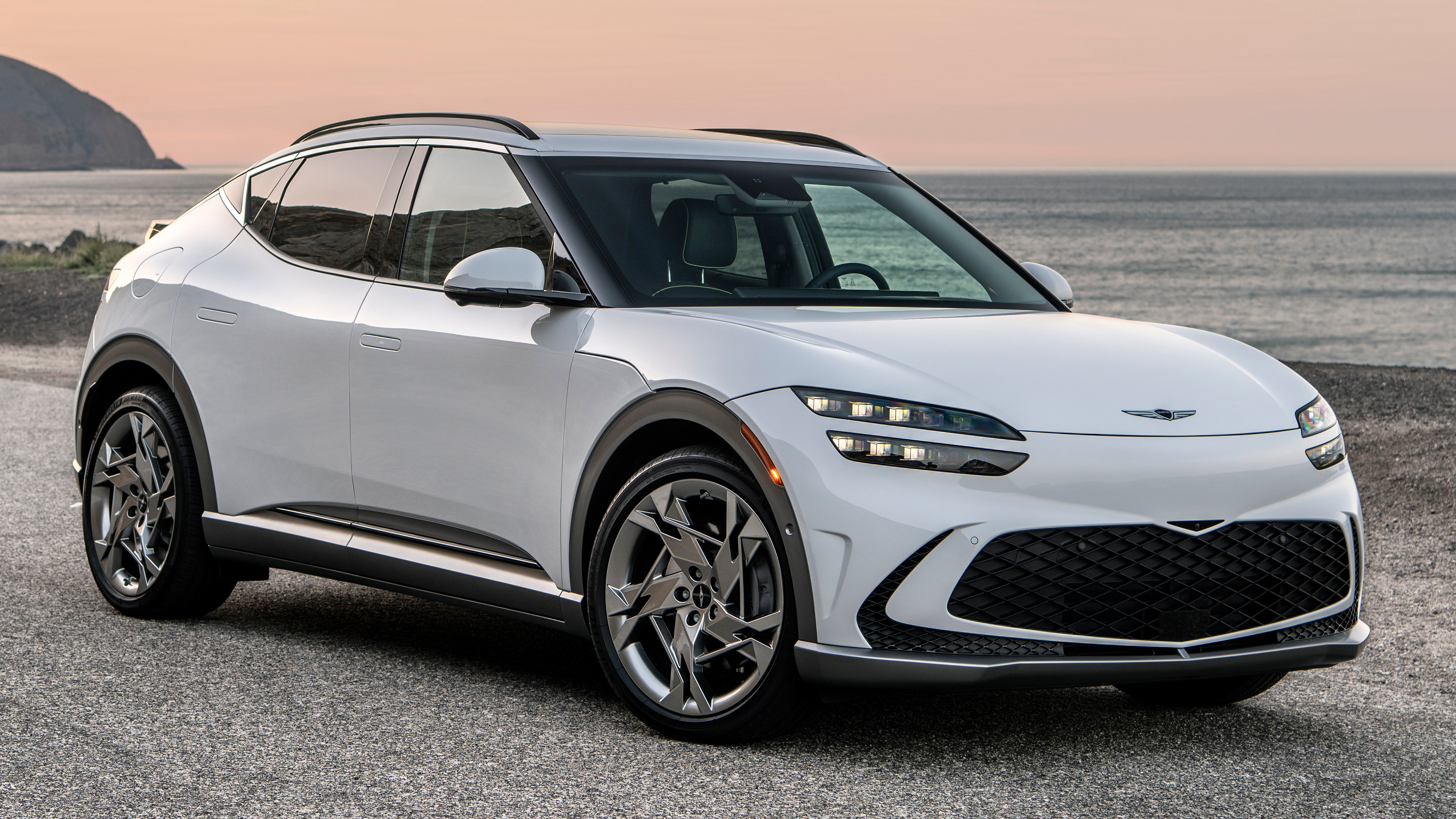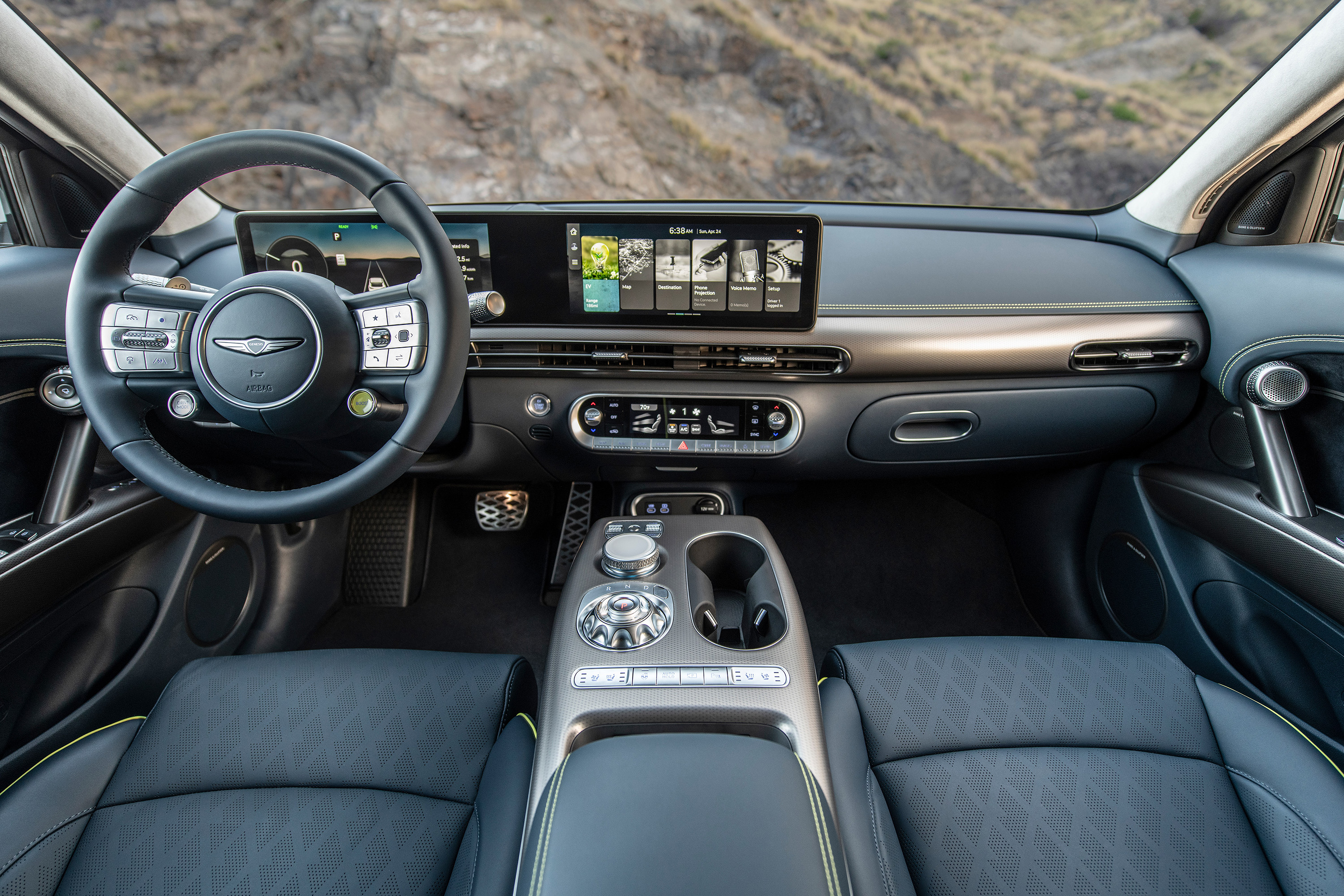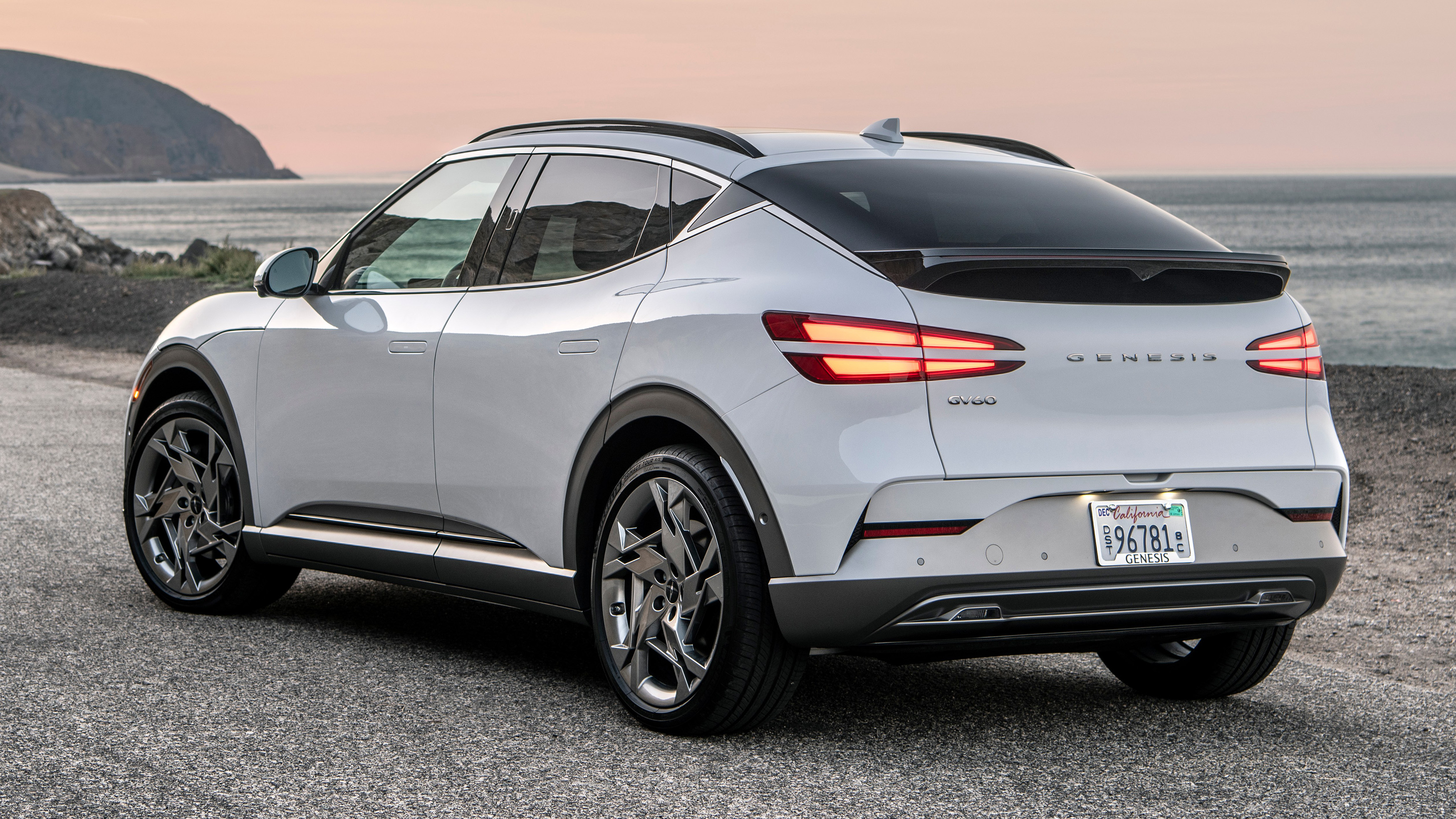2023 Genesis GV60
Right Vehicle At The Right Time
Genesis’ first foray into the world of battery electric vehicles was a modified version of their G80 sedan; and while it was a fantastic effort, getting the full benefits of an EV requires a dedicated EV chassis. So, you can probably see where this is going, this GV60 is their first to ride on Hyundai’s electric global modular platform, yet another new beginning for Genesis.
 The 2023 Genesis GV60 may be the brand’s first dedicated BEV, but it’s not entirely new to us, as it’s based on the Hyundai IONIQ5 which we tested a few months back and were quite impressed with. And like the IONIQ5, the GV60 is a capable handler, has good overall balance, a smooth ride, and swift acceleration; all things that help you enjoy driving, no matter what the power source.
The 2023 Genesis GV60 may be the brand’s first dedicated BEV, but it’s not entirely new to us, as it’s based on the Hyundai IONIQ5 which we tested a few months back and were quite impressed with. And like the IONIQ5, the GV60 is a capable handler, has good overall balance, a smooth ride, and swift acceleration; all things that help you enjoy driving, no matter what the power source.
The interior is uncluttered and modernly simple, due mostly to the open floorplan, but still highly luxurious; though the tall floating center console keeps it from feeling as roomy as it could. Materials are a mix of sustainably sourced plant-based leather and fabrics made from recycled plastic. A 12-inch high-def touchscreen for infotainment is standard, as is a 17-speaker B&O sound system and a fixed glass panoramic roof.
Just an LCD panel for gauges, which is typical these days, as are the touch-sensitive controls; but there are some unique features and controls to be found, like a boost button on the front of the steering wheel and brake regen paddles behind. We’re generally not fans of rotary style shifters, but when its disguised as a crystal ball, well it’s hard not to be entranced or look for answers. Will this car get to 60 in less than 4–seconds?
 Well, all signs point to yes, as this all-wheel-drive GV60 Performance features a 160-kW electric motor for each axle; outputting a total of 429-horsepower and 516 lb-ft. of torque. The standard Advanced edition has a smaller 74-kW motor up front for a 314-horsepower output, but gets the most range, at 248-miles. Our Performance tester is rated for just 235-miles, but there was an indicated 257 available at 100%. We drove conservatively, doing our best to drain the battery, and were indeed on pace to get 259-miles before needing to plug in. No surprise, the GV60 Performance also has a good efficiency rating of 36.8-kWh/100 miles.
Well, all signs point to yes, as this all-wheel-drive GV60 Performance features a 160-kW electric motor for each axle; outputting a total of 429-horsepower and 516 lb-ft. of torque. The standard Advanced edition has a smaller 74-kW motor up front for a 314-horsepower output, but gets the most range, at 248-miles. Our Performance tester is rated for just 235-miles, but there was an indicated 257 available at 100%. We drove conservatively, doing our best to drain the battery, and were indeed on pace to get 259-miles before needing to plug in. No surprise, the GV60 Performance also has a good efficiency rating of 36.8-kWh/100 miles.
Now, few would call the IONIQ5 gorgeous, but Genesis has certainly taken it in a new direction; with a smooth and purposeful design that showcases the “athletic elegance” side of the brand. Genesis hallmarks such as the barely there parallel lines for headlights and Crest grille remain; but the jagged-line chrome trim, rear spoiler, and color highlights, clearly take it in a sportier direction. Less obvious, is the new wing logo, made thinner to enhance aerodynamics, along with the pop out door handles. And if you happen to forget your key fob, you can access the car and get moving simply with facial recognition.
Since the crystal ball didn’t provide any answers, it was off to the track to get some hard numbers. And there was a tremendous amount of power delivered at launch, with a unique spaceship-like soundtrack along for the ride as we sprinted to 60, taking that full 4.0-seconds. Hitting that boost button on the steering wheel gives you max torque and the sensation that you just engaged warp speed.
 Power delivery stayed pretty intense until we hit 80 miles-per-hour, at which time it leveled off for a more serene finish to the ¼-mile. Our best time was 12.4-seconds at 112 miles-per-hour. The GV60 Performance clearly lives up to its name there, but a little less so when it comes to handling. We could really feel this utility’s weight through the cones, and it doesn’t seem to carry that weight as low as most EVs.
Power delivery stayed pretty intense until we hit 80 miles-per-hour, at which time it leveled off for a more serene finish to the ¼-mile. Our best time was 12.4-seconds at 112 miles-per-hour. The GV60 Performance clearly lives up to its name there, but a little less so when it comes to handling. We could really feel this utility’s weight through the cones, and it doesn’t seem to carry that weight as low as most EVs.
For now, all GV60s are all-wheel-drive, with the base Advanced starting at $59,985; the Performance at $68,985.
So, while the Genesis brand hasn’t been around all that long, big changes are already taking place. Jumping into the EV world with their G80 sedan was a fantastic start, and following it up with this 2023 GV60 utility seems to be the right vehicle at the right time. And, even in the automotive world, timing is indeed everything.
Specifications
- Motor Setup: Dual Motor
- Horsepower: 429
- Torque: 516 lb-ft
- 0-60 mph: 4.0 seconds
- 1/4 Mile: 12.4 seconds at 112 mph
- EPA Range: 235 miles
- MW Range: 259 miles
- Efficiency: 36.8-kWh/100 miles
2024 Honda Ridgeline TrailSport
It Does Truck-Like Things Better Than Ever
Honda brought something truly unique to the pickup truck scene when their mid-size Ridgeline debuted for 2006. In 2017, it moved towards becoming a little more true truck-like, both in form and capability, now with yet another step in that direction for 2024. So, let’s see if the Ridgeline is really hitting its stride.
For 2024, it’s all about making this Honda Ridgeline better than ever. There are styling tweaks outside, along with tech and functional improvements inside, but the biggest news is the Ridgeline has now joined Honda’s TrailSport family of off-road inspired vehicles. This more-true-trucklike, second-gen Ridgeline been around since 2017, receiving periodic updates over the years; but joining the TrailSport family is the biggest leap yet.
Primarily, the TrailSport transformation includes General Grabber all-terrain tires, mounted on new Pewter Gray 18-inch wheels, steel underbody protection, and retuning the strut front, and multi-link rear suspension for added wheel articulation. And while we always appreciate the additional traction of off-road tires, the Ridgeline’s standard i-VTM4 all-wheel drive, with Intelligent Traction Management and snow, sand, and mud settings, was already quite capable of handling all but the most extreme off-roading, ground clearance of just 7.6 inches being it’s only real hinderance.
A 3.5-liter V6 remains under the hood as it has since the Ridgeline debuted for 2006; the current version outputs 280 horsepower and 262 lb-ft of torque, plenty enough muscle to handle its 5,000-lbs. towing capacity. A nine-speed automatic transmission with paddle shifters and bevy of push and pull buttons on the console replaced the six-speed automatic back in 2020.
In addition to adding TrailSport capability, a big focus for this update was making it more user-friendly inside, starting with the central touchscreen growing from 8 to 9 inches. It also gets faster processing speeds, menus have been simplified, and the native navigation system is improved with better graphics. It’s accompanied by a new digital instrument cluster, along with an upgraded center console with more storage space. Unique TrailSport touches include heavy duty floormats, leather-trimmed seats, orange stitching throughout the cabin, and orange ambient lighting.
The Ridgeline continues to offer things available nowhere else in the pickup truck market.
Exterior styling doesn’t exactly shout “macho big rig coming your way,” but the more vertical face and larger grille that arrived for 2021, along with this year’s added TrailSport elements, do continue to toughen up the Ridgeline’s image. The 5’4” bed remains highly functional with no large wheel well intrusions, multiple tie-downs points, lighting and even speakers. And of course, the Ridgeline continues to offer things available nowhere else in the pickup truck market, like the dual-action tailgate, and large, lockable, drainable, underbed storage. Not to mention being able to drive around in true car-like comfort, something we took full advantage of on our way to our Mason Dixon Dragway test track.
There was great grip off the line, with full power arriving smoothly but quickly, helping us to get to 60 in 7.0 seconds flat, a tenth quicker than the last Ridgeline we tested. That power delivery stayed fairly consistent the whole way down the track, barely interrupted by the nine-speed automatic’s smooth shifting. Our best quarter-mile run was 15.5 seconds at 90 mph.

The revised suspension and knobbier tires didn’t really seem to add or detract from handling prowess, as it felt as solid, nimble, and car-like as it always has through our cone course. Perhaps a little less stiff than before, but good feedback, tight steering, and minimal body roll for a pickup, made for a very confidence inspiring experience. In our braking test, we stopped in a respectable average of 123 feet from 60, with only moderate amounts of nosedive and good feel through the pedal.
There is, however, a slight reduction in Government Fuel Economy Ratings with the all-terrain tires; 18-City, 23-Highway, and 20-Combined, our average, right on, at 20.4 mpg of Regular. That’s a slightly below average Energy Impact Score of 14.9 barrels of yearly oil use, with CO2 emissions of 7.4 tons.
TrailSport pricing falls in line just under the Ridgeline’s top Black Edition trim with a starting price of $46,375, about five grand over a base Ridgeline Sport.
So, whether you consider the Honda Ridgeline to be a “real” truck or not, this ruggedly smooth 2024 TrailSport does truck-like things better than ever. And we’re not just talking about the slight upgrade in off-road performance, we’re talking about a flexible bed to help you get chores done, and the ability to tow or haul with comfort and flexibility other trucks can only wish for. It’s why the Ridgeline brings more first-time buyers to Honda than any other vehicle, and why it continues to be a great choice in the growing midsize truck realm.
Specifications
- Engine: 3.5-liter V6
- Transmission: 9-speed automatic
- Horsepower: 280
- Torque: 262 lb-ft
- EPA: 18 City | 23 Highway | 20 Combined
- 0-60 mph: 7.0 seconds
- 1/4 Mile: 15.5 seconds at 90 mph
- 60-0 Braking (avg): 123 feet
- MW Fuel Economy: 20.4 mpg (Regular)
- Max Towing Capacity: 5,000-lbs








